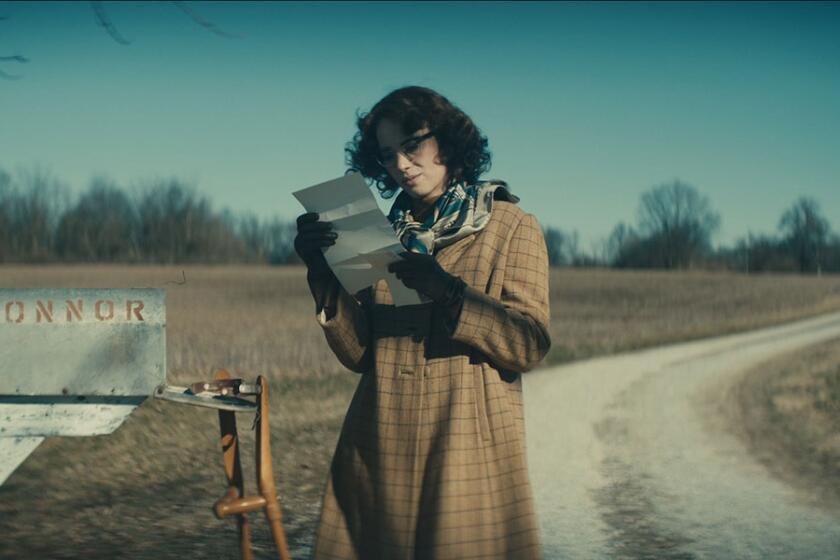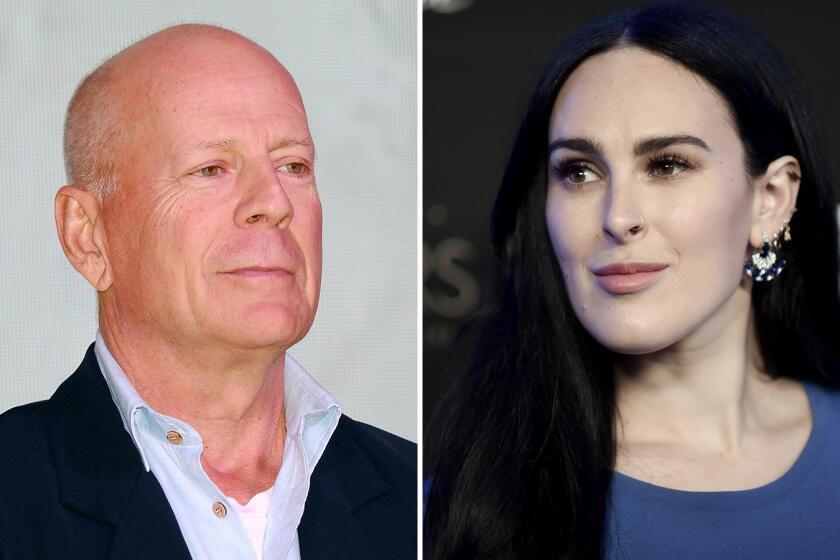Peter Ellenshaw, 93; Oscar-winning special effects artist for Disney
Peter Ellenshaw, an Academy Award-winning special effects artist who worked on Disney classics such as “20,000 Leagues Under the Sea,” “Darby O’Gill and the Little People” and “Mary Poppins,” for which he won his Oscar, has died. He was 93.
Ellenshaw, who also was a renowned sea and landscape artist, died of age-related complications Monday at his home in Santa Barbara, said his son, Harrison.
The British-born Ellenshaw’s more than 30-year association with Walt Disney Studios began in 1947 when he was hired in London to do matte paintings for Disney’s first live-action film, “Treasure Island” (1950).
In 1953, he was brought to California to work on “20,000 Leagues Under the Sea,” for which he created several matte paintings of Capt. Nemo’s secret island base of Vulcania.
He went on to do matte paintings and other special effects for more than 30 other Disney films, including “The AbsentMinded Professor,” “Pollyanna,” “Swiss Family Robinson,” “The Happiest Millionaire,” “The Love Bug” and “The Black Hole.” He also did matte paintings for Disney TV fare, such as “Davy Crockett, King of the Wild Frontier,” “Zorro” and “Texas John Slaughter.”
“He’s one of the titans of visual effects in an era before people took visual special effects for granted,” film critic and historian Leonard Maltin told The Times on Wednesday.
Unlike the digital special effects of today, Maltin explained, “a matte painter literally painted on panes of glass that, when suspended properly in front of the camera or double-exposed, give a perfect illusion.
“So when you see London Harbor full of tall-masted schooners in ‘Treasure Island,’ that’s an Ellenshaw painting. When Mary Poppins sails over the rooftops of London, that’s an Ellenshaw painting. And when Davy Crocket rides down the path to Washington, that’s an Ellenshaw painting.”
Ellenshaw also contributed to the design of several rides at Disneyland and painted the first map of the Magic Kingdom, which appeared on early postcards and souvenir booklets at the Anaheim theme park.
“Peter was a Disney legend in every sense of the word and played a vital role in the creation of many of the studio’s greatest live-action films from the very beginning,” Roy E. Disney, former vice chairman of the Walt Disney Co., said in a statement. “He was a brilliant and innovative visual effects pioneer who was able to consistently please my Uncle Walt and push the boundaries of the medium to fantastic new heights.”
Born in London on May 24, 1913, Ellenshaw moved to Essex, England, with his parents and two sisters during World War I, when he was 3. He later recalled seeing German zeppelins in the sky.
“My mother put us under the kitchen table while they were overhead and gave us pencils and paper to draw with,” he recalled in a 1980 interview with The Times. “After the age of 4, I learned to draw airplanes; in fact, that got me interested in art.”
His father died while Ellenshaw was still young and his mother married a gardener who worked on an estate. To help support the family, Ellenshaw dropped out of school at 14 and spent the next six years working on cars in a garage while continuing to paint.
By then living in the small town of Oxbridge, near the London film studios, he became friends with renowned matte artist Walter Percy Day, who eventually offered him a job. From 1935 to 1941, Ellenshaw worked as an uncredited assistant matte artist on a dozen films, including “The Thief of Bagdad” and “Major Barbara.”
Ellenshaw served in the Royal Air Force during World War II, and then worked as a matte artist on “Black Narcissus,” “Stairway to Heaven,” “Quo Vadis” and other films.
After doing special effects and the production design on the 1974 Disney adventure-fantasy “The Island at the Top of the World” -- for which he shared an Oscar nomination for best art direction -- Ellenshaw and his wife moved to Ireland, where he painted landscapes for a couple of years before returning to California.
From then on, he did only occasional film work, including the 1979 Disney space adventure “The Black Hole,” for which he shared an Oscar nomination for best visual effects.
Ellenshaw, who also shared an Oscar nomination for art direction for the 1971 film “Bedknobs and Broomsticks,” came out of retirement for the last time to do matte paintings for the 1990 film “Dick Tracy.”
Bobbie, Ellenshaw’s wife of 58 years, died in 2000. In addition to his son Harrison, who is a visual effects artist, Ellenshaw is survived by his daughter, Lynda Ellenshaw Thompson, a visual effects producer, and two grandchildren.
Funeral services will be private. Instead of flowers, donations may be made to Direct Relief International, 27 S. La Patera Lane, Santa Barbara, CA 93117.
*
More to Read
Only good movies
Get the Indie Focus newsletter, Mark Olsen's weekly guide to the world of cinema.
You may occasionally receive promotional content from the Los Angeles Times.






